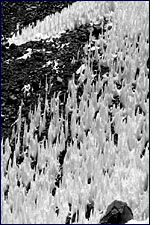 While we were waiting for our bodies to adjust to the altitude, we made
friends with Jesus, the ranger at Lake Chungara. He walked around with
us and showed us the sights: strange hemispherical llareta plants that
the locals chop up for firewood, a creature called a vizcacha that looked
like a cross between a rabbit and a chinchilla, and three-toed footprints
running across the desert that, to me, looked like the prints of a dinosaur
-- perhaps Struthiomimus. Jesus laughed at my dinosaur conjecture and
said that they were tracks of a rhea, a South American ostrichlike bird.
While we were waiting for our bodies to adjust to the altitude, we made
friends with Jesus, the ranger at Lake Chungara. He walked around with
us and showed us the sights: strange hemispherical llareta plants that
the locals chop up for firewood, a creature called a vizcacha that looked
like a cross between a rabbit and a chinchilla, and three-toed footprints
running across the desert that, to me, looked like the prints of a dinosaur
-- perhaps Struthiomimus. Jesus laughed at my dinosaur conjecture and
said that they were tracks of a rhea, a South American ostrichlike bird.
 Jesus
was a local Aymara Indian. He had a huge chest, indicating a large lung
capacity, and he could hike us into the ground. He is as fit and as comfortable
at Lake Chungara as Bob and I are on the coast of California. The Aymara
have lived at these elevations for thousands of years and they are superbly
adapted for altitude. But it seems that people can adjust to low oxygen
conditions only to a certain limit -- no place on earth has any permanent
human habitation higher than 17,000 feet.
Jesus
was a local Aymara Indian. He had a huge chest, indicating a large lung
capacity, and he could hike us into the ground. He is as fit and as comfortable
at Lake Chungara as Bob and I are on the coast of California. The Aymara
have lived at these elevations for thousands of years and they are superbly
adapted for altitude. But it seems that people can adjust to low oxygen
conditions only to a certain limit -- no place on earth has any permanent
human habitation higher than 17,000 feet.
![]()
 After three days we began to feel better, so we decided to tackle the
mountain. We climbed to 17,000 feet, where we camped for the night and
enjoyed a tremendous view. In the morning, we continued up the route,
but the rarefied air compelled us to go slowly. For every step, we had
to take two deep breaths. Then, at about 18,000 feet, we came to a sea
of neve penetentes -- acres of sharp ice blades, each about three feet
high, spaced a foot or two apart. These ice swords, carved by equatorial
sunlight, slowed our ascent nearly to a stop. We might have made it to
the top if we'd had more time, but we realized that we couldn't get to
the summit and then back down the mountain in time for the eclipse. We
decided to retreat.
After three days we began to feel better, so we decided to tackle the
mountain. We climbed to 17,000 feet, where we camped for the night and
enjoyed a tremendous view. In the morning, we continued up the route,
but the rarefied air compelled us to go slowly. For every step, we had
to take two deep breaths. Then, at about 18,000 feet, we came to a sea
of neve penetentes -- acres of sharp ice blades, each about three feet
high, spaced a foot or two apart. These ice swords, carved by equatorial
sunlight, slowed our ascent nearly to a stop. We might have made it to
the top if we'd had more time, but we realized that we couldn't get to
the summit and then back down the mountain in time for the eclipse. We
decided to retreat.
After our climb to higher altitudes, the air at 15,000 feet seemed rich in oxygen, and we were breathing comfortably. We found a prime eclipse-watching spot -- a view of the sun over an erupting volcano -- that we shared with a herd of alpaca. We marveled at the sun's corona, which had protuberances sticking out like spider legs into the black sky.
We had a plane to catch the morning after the eclipse, so we weren't able to give Mount Parinacota another try. We decided that we'd just have to make another trip to Chile.
To be better prepared for a future climb, I did some reading about altitude illnesses after I got back home. The best preventive measure, the experts say, is to take your time. Climb high each day and then return to sleep lower. I learned that most people shouldn't sleep higher than 7000 or 8000 feet above sea level on their first night, then sleep a thousand feet higher each subsequent night. Bob and I seem to be able to climb at a somewhat faster rate than this, but not quite so fast as we tried to go on Parinacota.
We're returning to Chile later this year, and it will be a more leisurely journey than our first one. We'll stop for a few days at cities along our route to sightsee and to adapt slowly to higher altitudes. Before we reach Mount Parinacota, we'll try to be as fit as two sea-level dwellers can be--and this time we plan to make it to the summit.
"Going Up? Get Fit" is just one of several interesting articles in the Fitness issue of Exploratorium Magazine. Other articles discuss the history of fitness crazes; health disorders associated with women athletes; fitness and hockey players; obesity research; and more. There's also an engaging photo essay on disabled dancers.
